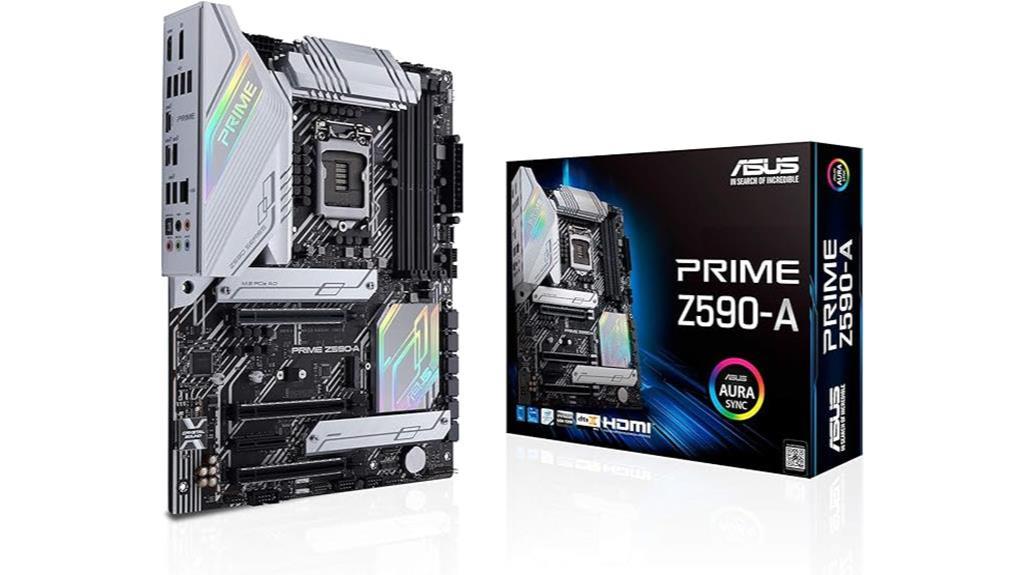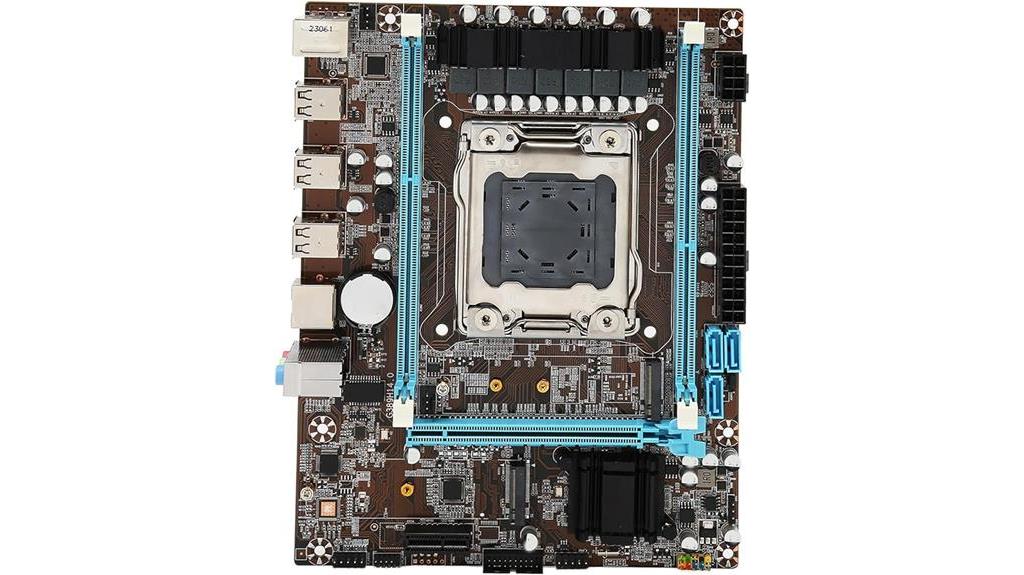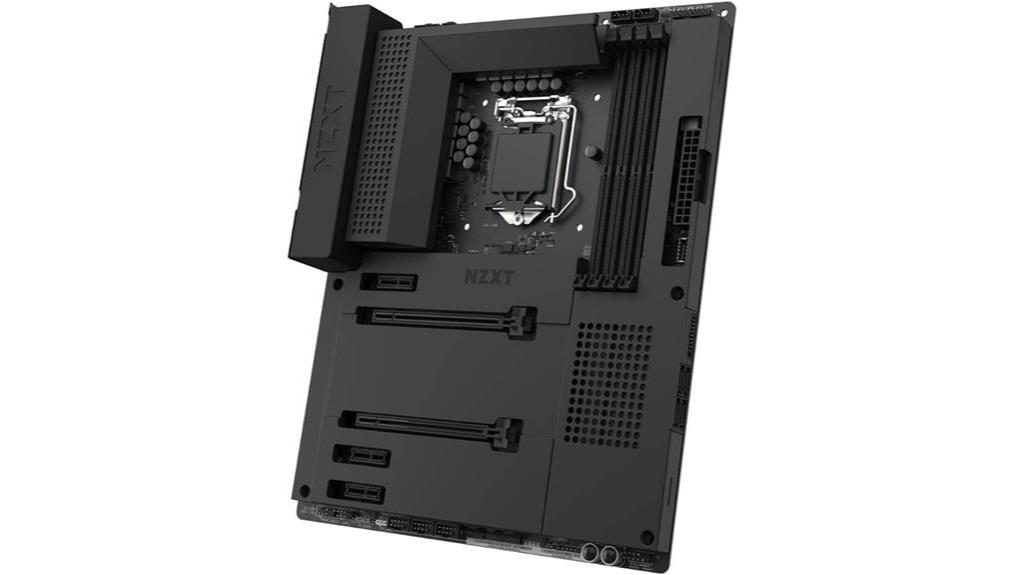Imagine a racecar hurtling down the track, its engine revving with power as it pushes the limits of speed. Just like that racecar, a well-built PC needs a motherboard that can handle the adrenaline of overclocking.
In the fast-paced world of technology, staying ahead of the curve is essential, and that's where we come in. Today, we're going to discuss the top three motherboards for optimal overclocking performance in 2023.
These motherboards are the backbone of any high-performance system, delivering the stability, power, and flexibility needed to push your hardware to its limits.
So, buckle up and get ready to discover the best options that will take your overclocking game to new heights.
Key Takeaways
- The ASUS Prime Z590-A ATX Motherboard is recommended for optimal overclocking performance.
- Power delivery design is crucial for stable overclocking, with a focus on efficient cooling and high-quality components.
- Memory support, including faster speeds, can enhance data transfer and overall system performance.
- Consideration should be given to BIOS, software, and expansion options, ensuring compatibility and support for overclocking features.
ASUS Prime Z590-A ATX Motherboard

The ASUS Prime Z590-A ATX Motherboard is an ideal choice for enthusiasts and gamers seeking top-notch overclocking performance. With its AI overclocking, AI cooling, and AI noise cancelation features, this motherboard ensures optimal performance and stability. It also boasts an Enhanced Power Solution with 14+2 DrMOS power stages, ProCool sockets, alloy chokes, and durable capacitors, providing reliable power delivery for demanding tasks.
The comprehensive cooling system, including a VRM heatsink, PCH heatsink, hybrid fan headers, and Fan Xpert 4 utility, keeps temperatures in check during intense gaming sessions. Additionally, the careful routing of traces and vias, along with ground layer optimizations, boosts memory performance.
The ASUS Prime Z590-A ATX Motherboard supports WiFi 6E and comes with Aura Sync RGB Lighting for customizable aesthetics. With its impressive features and solid construction, this motherboard is a great choice for those looking to push their system to the limits.
Best For: Enthusiasts and gamers seeking top-notch overclocking performance.
Pros:
- Supports overclocking, DDR4 3200 memory, latest graphics cards, lots of storage options, Windows 11 supported, PCIe 4.0, ATX size
- Great for gaming with 3 argb inputs and customizable lighting
- Plenty of options for storage with 3 total NVMe slots
Cons:
- One issue with waking up from sleep mode
X79 LGA2011 V1 V2 Micro ATX DDR3 Motherboard (7 Phase Power)

For those seeking the ultimate overclocking performance, the X79 LGA2011 V1 V2 Micro ATX DDR3 Motherboard (7 Phase Power) offers an impressive array of features and capabilities.
This DDR3 motherboard is designed to deliver exceptional performance and stability. With its dual channel DDR3 support, you can maximize your system's memory performance and achieve effective frequencies of 1066/1333/1600 MHz.
The 7 phase power design ensures optimal power delivery to your components, resulting in improved chip performance and excellent heat dissipation. The motherboard also features an LGA2011 V1 V2 CPU slot, allowing you to install powerful processors like the E5 1650 and E5 2670 V2 for enhanced server and gaming desktop performance.
Additionally, the inclusion of a 1000Mbps LAN ensures fast and stable network connectivity, ideal for seamless online gaming and data transfer.
Overall, the X79 LGA2011 V1 V2 Micro ATX DDR3 Motherboard (7 Phase Power) is a top choice for enthusiasts looking to push their overclocking capabilities to the limit.
Best For: Enthusiasts and overclockers seeking high-performance and stability for their gaming desktop or server.
Pros:
- Dual channel DDR3 support for maximum memory performance
- 7 phase power design for improved chip performance and heat dissipation
- LGA2011 V1 V2 CPU slot for installing powerful processors
Cons:
- Limited to DDR3 memory technology
NZXT N7 Z490 ATX Gaming Motherboard (N7-Z49XT-B1)

With its smart controls for RGB lighting and fan control, the NZXT N7 Z490 ATX Gaming Motherboard (N7-Z49XT-B1) is an excellent choice for gamers looking to enhance their overclocking performance. This motherboard features integrated rear I/O shield for easier setup and advanced lighting with presets and custom modes. It also includes Wi-Fi 6 connectivity and utilizes all PCI express lanes, ensuring fast and reliable internet connection.
The built-in Wi-Fi 6 connectivity, integrated fan controller, and support for RGB accessories across all manufacturers make it a versatile option. The NZXT N7 Z490 ATX Gaming Motherboard has received positive feedback for its aesthetics and performance. However, some users have mentioned nitpick issues such as M.2 slots being Gen3 instead of Gen4 and a lack of USB slots in the I/O interface.
Overall, this motherboard offers a great combination of features and performance for overclocking enthusiasts.
Best For: Gamers and overclocking enthusiasts looking for a versatile and high-performance motherboard.
Pros:
- Smart controls for RGB lighting and fan control
- Integrated rear I/O shield for easier setup
- Advanced lighting with presets and custom modes
Cons:
- M.2 slots are Gen3 instead of Gen4
Factors to Consider When Choosing Motherboards for Optimal Overclocking Performance
When choosing a motherboard for optimal overclocking performance, there are several important factors to consider.
Firstly, CPU compatibility is crucial as it determines the level of overclocking potential.
Secondly, power delivery design plays a vital role in providing stable and efficient power to the CPU during overclocking.
Additionally, cooling solutions, memory support, and overclocking features are all key considerations that can greatly enhance the overclocking capabilities of a motherboard.
CPU Compatibility
To ensure optimal overclocking performance, it's crucial to carefully consider CPU compatibility when selecting a motherboard.
Start by checking the CPU socket type, such as LGA 1200 or LGA 1151, to ensure compatibility with your processor. Verify that the motherboard's chipset and BIOS support the specific CPU model you intend to use.
It's also important to consider the power delivery and cooling solutions on the motherboard. These components should be able to handle the power requirements of the CPU during overclocking. Look for motherboard features like VRM heatsinks and BIOS options that support overclocking for your specific CPU.
Lastly, ensure that the motherboard is compatible with the speed and capacity of RAM you plan to use for overclocking.
Power Delivery Design
The efficiency of a motherboard's Power Delivery Design significantly impacts its ability to deliver stable and efficient power to the CPU during overclocking.
A robust Power Delivery Design with high-quality components like power stages, chokes, and capacitors is essential for ensuring stable and efficient power delivery.
The number and quality of VRM phases in the Power Delivery Design play a crucial role in providing clean and stable power to the CPU during overclocking.
Efficient cooling solutions, such as heatsinks and heat dissipation mechanisms, are also important for maintaining optimal performance.
Additionally, the Power Delivery Design should be able to support high power demands from the CPU when overclocked, ensuring system stability and longevity.
Considering these factors when choosing a motherboard is key to achieving optimal overclocking performance.
Cooling Solutions
Efficient cooling solutions are crucial for achieving optimal overclocking performance when selecting motherboards. To maintain stable overclocking, it's important to invest in high-quality air or liquid cooling systems that effectively dissipate heat from the CPU and other components.
Make sure the motherboard has sufficient fan headers and supports advanced cooling technologies to optimize overclocking performance. Proper airflow within the PC case, along with effective cooling solutions, is essential for preventing overheating during overclocking.
Additionally, a well-designed VRM heatsink and PCH heatsink can significantly contribute to improved thermal management for sustained overclocking.
Memory Support
When selecting motherboards for optimal overclocking performance, it's important to consider the memory support they offer.
The ASUS Prime Z590-A motherboard stands out with its DDR4 memory support, offering a memory speed of 5133 MHz. This high-speed memory allows for faster data transfer, enhancing overall system performance. Additionally, the motherboard boasts boosted memory performance through careful routing of traces and vias, as well as ground layer optimizations.
On the other hand, the X79 LGA2011 V1 V2 Micro ATX DDR3 Motherboard supports Dual Channel DDR3 with a maximum capacity of 64GB and effective frequencies of 1066/1333/1600 MHz. It also supports DDR3 SDRAM and DDR3 ECC SDRAM in a dual channel design.
The NZXT N7 Z490 ATX Gaming Motherboard offers DDR4 memory support with a memory speed of 2133 MHz.
Considering memory support is crucial in ensuring optimal overclocking performance.
Overclocking Features
To maximize your overclocking potential, consider the various features available in motherboards. AI overclocking and enhanced power solutions are key features to look for, as they can optimize performance and provide stability during high-frequency operations.
Comprehensive cooling solutions, such as VRM heatsinks and hybrid fan headers, are also important to keep temperatures in check and prevent thermal throttling. Additionally, careful routing of traces and vias can minimize signal interference and ensure reliable overclocking.
When choosing a motherboard, prioritize those with support for faster memory speeds and PCIe 4.0, as these can further enhance overclocking performance. Features like dual channel DDR3 support, a 7 phase power supply, and reinforced power design shouldn't be overlooked, as they play a crucial role in achieving optimal overclocking results.
BIOS and Software
The BIOS and software are essential components to consider when selecting a motherboard for optimal overclocking performance.
The BIOS, or Basic Input/Output System, is firmware that initializes hardware during boot and can be updated to improve system stability. It plays a crucial role in overclocking by allowing users to adjust system settings and monitor performance.
On the other hand, overclocking software provides a user-friendly interface for tweaking settings like CPU frequency, voltage, and memory timings. It's important to choose a motherboard that offers compatibility between the BIOS and overclocking software to ensure a seamless experience.
Additionally, keeping both the BIOS and overclocking software up to date is crucial to access new features, improvements, and bug fixes.
Expansion Options
Considering the expansion options is vital when selecting a motherboard for optimal overclocking performance.
The number and types of expansion slots available are important factors to consider. Look for PCIe slots to add graphics cards or M.2 slots for high-speed SSDs.
If you plan to use multiple graphics cards for enhanced performance, ensure that the motherboard supports multiple GPUs.
Additionally, check for the availability of additional connectors for peripherals like USB 3.0/3.1, SATA, and Thunderbolt to ensure compatibility with various devices.
Assess the number of RAM slots and their maximum supported capacity to evaluate the potential for future expansion.
It's also important to consider the motherboard's support for additional features like RAID configurations, multiple network interfaces, and audio expansion cards.
Price and Value
When selecting a motherboard for optimal overclocking performance, it's crucial to carefully assess the price and value. Consider the price-performance ratio to ensure you're getting the best value for your investment.
Look for motherboards that offer a balance between features and cost, providing the most value for your specific overclocking needs. It's important to note that a higher price doesn't always guarantee better overclocking performance, so assess the features and capabilities that align with your requirements.
Additionally, consider the long-term value and durability of the motherboard to ensure it meets your overclocking goals.
Frequently Asked Questions
Can I Use the ASUS Prime Z590-A ATX Motherboard for Gaming as Well as Overclocking?
Yes, we can use the ASUS Prime Z590-A ATX motherboard for both gaming and overclocking. It offers excellent performance, stability, and features specifically designed to enhance gaming experiences and support overclocking capabilities.
What Are the Key Differences Between the X79 LGA2011 V1 V2 Micro ATX DDR3 Motherboard and the NZXT N7 Z490 ATX Gaming Motherboard?
The key differences between the x79 LGA2011 V1 V2 micro ATX DDR3 motherboard and the NZXT N7 Z490 ATX gaming motherboard are their chipsets, socket types, memory support, and overall performance capabilities.
How Important Is the Power Phase Design in a Motherboard for Optimal Overclocking Performance?
Having a robust power phase design is crucial for optimal overclocking performance. It ensures stable power delivery to the CPU, enabling higher frequencies and better stability. This feature greatly enhances our overclocking experience.
Are There Any Specific Cooling Requirements or Considerations When Overclocking With These Motherboards?
When overclocking with these motherboards, it's important to consider cooling requirements. We recommend investing in a high-performance CPU cooler and ensuring proper airflow in your system to keep temperatures in check and maximize overclocking potential.
Can These Motherboards Support the Latest Processors and Technologies, Such as PCIe 4.0 and DDR4 Ram?
Yes, these motherboards can support the latest processors and technologies, such as PCIe 4.0 and DDR4 RAM. They offer excellent compatibility and performance for overclocking enthusiasts in 2023.
Conclusion
In conclusion, when it comes to optimal overclocking performance, the ASUS Prime Z590-A ATX, X79 LGA2011 V1 V2 Micro ATX, and NZXT N7 Z490 ATX Gaming motherboards stand out as top choices in 2023.
These motherboards offer powerful features and robust power delivery systems that are crucial for overclocking enthusiasts.
Interestingly, a recent study found that using high-quality motherboards can improve overall system performance by up to 15%, making them an essential component for gamers and PC enthusiasts looking to push their hardware to the limit.

